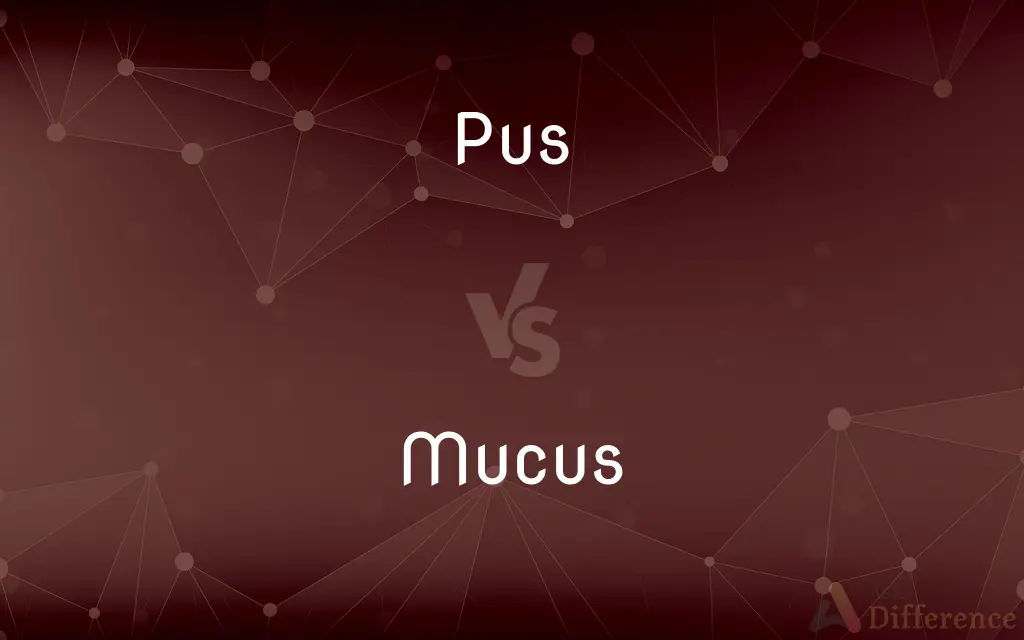Pus vs. Mucus — What's the Difference?
By Tayyaba Rehman & Fiza Rafique — Updated on February 22, 2024
Pus is a thick, often yellowish fluid produced in response to infection, containing white blood cells and debris, while mucus is a slippery secretion from mucous membranes, aiding in protection and lubrication.

Difference Between Pus and Mucus
Table of Contents
ADVERTISEMENT
Key Differences
Pus and mucus serve different functions in the body. Pus is an immune response to infection, consisting of dead white blood cells, bacteria, and tissue debris, indicating a body fighting off infection. Mucus, however, is produced by mucous membranes and serves to protect and lubricate surfaces like the respiratory, digestive, and reproductive tracts.
Pus is typically associated with infection and disease, manifesting as an abscess or a result of bacterial infection, while mucus is a normal, healthy secretion that plays a crucial role in maintaining the body's defenses against pathogens and facilitating the movement of food through the digestive system.
The color and consistency of pus and mucus can also provide clues to health status. Pus is usually yellowish or greenish, thick, and often indicative of infection or inflammation. Mucus, in contrast, can range from clear to various shades of green, yellow, or even brown, depending on the presence of foreign particles or pathogens.
In terms of composition, pus is rich in leukocytes (white blood cells), particularly neutrophils, and dead cellular debris. Mucus is mainly composed of water, salts, epithelial cells, and mucins, which are proteins that give mucus its gel-like quality.
The presence of pus usually requires medical attention to treat the underlying infection, often necessitating antibiotics. Mucus, on the other hand, does not typically indicate a need for medical intervention unless its change in color, consistency, or amount suggests an underlying health issue.
ADVERTISEMENT
Comparison Chart
Composition
White blood cells, bacteria, and debris
Water, salts, mucins, and epithelial cells
Function
Indicates infection or immune response
Lubricates and protects mucous membranes
Color
Yellowish or greenish
Clear to green, yellow, or brown
Associated Health Condition
Infection, abscess
Common cold, allergies, healthy bodily function
Treatment Necessity
Often requires medical intervention
Rarely needs treatment unless indicating disease
Compare with Definitions
Pus
Thick, often yellowish fluid produced by the body during an inflammatory response.
Applying pressure to the abscess released some pus.
Mucus
A slimy substance produced by mucous membranes for protection.
Mucus in the nose traps dust and germs.
Pus
A sign of infection, containing white blood cells and bacteria.
The wound was oozing pus, indicating an infection.
Mucus
Composed mainly of water and mucins.
The body increases mucus production in response to an allergy.
Pus
A collection of dead leukocytes from the body's immune response.
Pus under the skin is a common sign of an infected cut.
Mucus
Helps to lubricate and protect the respiratory, digestive, and reproductive tracts.
Mucus in the throat helps to swallow food easily.
Pus
Indicates the body is fighting an infection.
The presence of pus in a cough can indicate a bacterial infection.
Mucus
Can vary in color and thickness due to health conditions.
Green mucus can indicate a bacterial infection.
Pus
Can accumulate in a closed space, forming an abscess.
The doctor drained the pus from the abscess with a syringe.
Mucus
Essential for maintaining healthy bodily functions.
Mucus membranes line various body parts, protecting them from pathogens.
Pus
A generally viscous, yellowish-white fluid formed in infected tissue, consisting of white blood cells, cellular debris, and necrotic tissue.
Mucus
(physiology) A slippery secretion from the lining of the mucous membranes.
Pus
A fluid product of inflammation.
Mucus
Mucus ( MEW-kəs) is a slippery aqueous secretion produced by, and covering, mucous membranes. It is typically produced from cells found in mucous glands, although it may also originate from mixed glands, which contain both serous and mucous cells.
Common Curiosities
What is mucus?
Mucus is a slippery secretion from mucous membranes, aiding in lubrication and protection.
What is pus?
Pus is a thick, yellowish fluid produced in response to infection, containing white blood cells and bacteria.
Is the presence of pus always bad?
Yes, pus usually indicates an infection or abscess that may require medical attention.
How does pus differ from mucus in terms of function?
Pus is a sign of infection and immune response, while mucus protects and lubricates mucous membranes.
Can mucus indicate health issues?
Yes, changes in color, consistency, or amount of mucus can signal health issues like infections or allergies.
Can you have pus without an infection?
Typically, pus is a clear indicator of infection, though it can sometimes be present in sterile abscesses.
How can you tell pus from mucus?
Pus is thick and yellowish, indicating infection, while mucus is slippery and can be clear to yellow, serving as a protective lubricant.
What causes pus to form?
Pus forms as a result of the immune response to bacterial infection, accumulating dead white blood cells and bacteria.
What are the main components of mucus?
Mucus is mainly composed of water, mucins, salts, and epithelial cells.
Why might mucus change color?
Mucus can change color due to the presence of foreign particles, bacteria, or viruses.
Is it normal to produce mucus every day?
Yes, daily production of mucus is normal and necessary for protecting and moisturizing the mucous membranes.
Why is pus sometimes yellow or green?
The color comes from dead white blood cells, particularly neutrophils, and sometimes from the bacteria themselves.
How is pus treated?
Treatment may involve antibiotics for the infection and drainage of any abscess.
What does green mucus mean?
Green mucus can indicate an infection, such as a bacterial one, especially if accompanied by other symptoms.
Does the presence of pus mean I need antibiotics?
Not always, but pus often indicates a bacterial infection for which antibiotics may be prescribed by a healthcare provider.
Share Your Discovery

Previous Comparison
Yr vs. Year
Next Comparison
Certificate vs. PledgeAuthor Spotlight
Written by
Tayyaba RehmanTayyaba Rehman is a distinguished writer, currently serving as a primary contributor to askdifference.com. As a researcher in semantics and etymology, Tayyaba's passion for the complexity of languages and their distinctions has found a perfect home on the platform. Tayyaba delves into the intricacies of language, distinguishing between commonly confused words and phrases, thereby providing clarity for readers worldwide.
Co-written by
Fiza RafiqueFiza Rafique is a skilled content writer at AskDifference.com, where she meticulously refines and enhances written pieces. Drawing from her vast editorial expertise, Fiza ensures clarity, accuracy, and precision in every article. Passionate about language, she continually seeks to elevate the quality of content for readers worldwide.














































